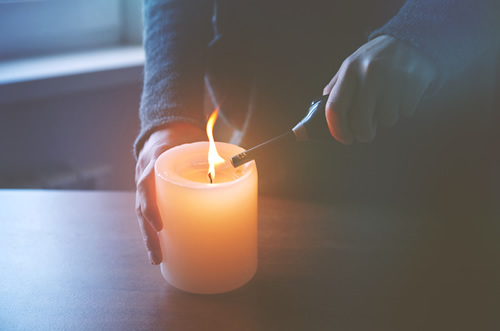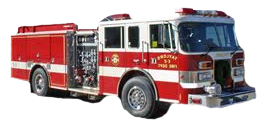Fire Safety – Candle Safety
 From 2014-2018, U.S. fire departments responded to an estimated 7,610 home structure fires that were started by candles per year. These fires caused an annual average of 81 deaths, 677 injuries, and $278 million in direct property damage.
From 2014-2018, U.S. fire departments responded to an estimated 7,610 home structure fires that were started by candles per year. These fires caused an annual average of 81 deaths, 677 injuries, and $278 million in direct property damage.
Remember that a candle is an open flame, which means that it can easily ignite anything that can burn. NFPA shares a few candle fire safety tips to consider.
During the five-year period of 2014-2018:
- Candles caused 2% of reported home fires, 3% of home fire deaths, 6% of home fire injuries, and 4% of the direct property damage in home fires.
- Roughly one-third (37%) of home candle fires started in bedrooms. These fires caused 40% of the associated deaths and 49% of the associated injuries.
- Falling asleep was a factor in 10% percent of the home candle fires and 15% of the associated deaths.
- On average, 21 home candle fires were reported per day.
- Three of every five (60%) home candle fires occurred when some form of combustible material was left or came too close to the candle.
- December is the peak time of year for home candle fires. In December, 12% of home candle fires began with decorations compared to 4% the rest of the year.
Source: NFPA’s Home Candle Fires report
Candles may be pretty to look at, but they can cause home fires — and home fire deaths. Remember, a candle is an open flame, which means that it can easily ignite anything that can burn.
Candle with Care
- Never leave a burning candle unattended. Burning candles can start a fire.
- Blow out all candles when you leave the room or go to bed. Avoid the use of candles in bedrooms, bathrooms, and other areas where people may fall asleep.
- Keep candles at least 12 inches away from anything that can burn.
- Consider using battery-operated flameless candles, which can look, smell, and feel like real candles.
- When using candles, please place them in sturdy, safe candle holders that will not burn or tip over.
- Protect candle flames with glass chimneys or containers.
- Use only battery-powered lights in tents, trailers, motor homes, and boats.
- Handheld candles should not be passed from one person to another at any time.
If you do burn candles, make sure that you…
- Use candle holders that are sturdy and won’t tip over easily.
- Put candle holders on a sturdy, uncluttered surface.
- Light candles carefully. Keep your hair and any loose clothing away from the flame.
- Don’t burn a candle all the way down — put it out before it gets too close to the holder or container.
- Never use a candle where medical oxygen is being used. The two can combine to create a large, unexpected fire. Medical oxygen can cause materials to ignite more easily
and burn at a faster rate than normal. It can make an existing fire burn faster and hotter. - Have flashlights and battery-powered lighting ready to use during a power outage. Never use candles.
Candles and Kids
- Never leave a child alone in a room with a burning candle.
- Keep matches and lighters up high and out of children’s reach in a locked cabinet.
Printable Candle Safety Tips from NFPA




